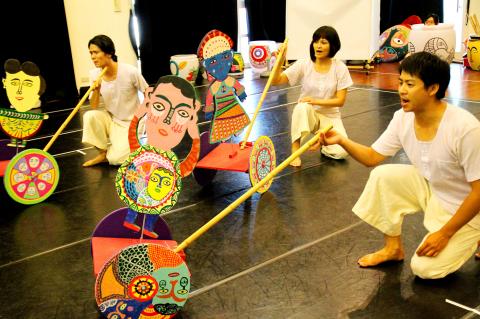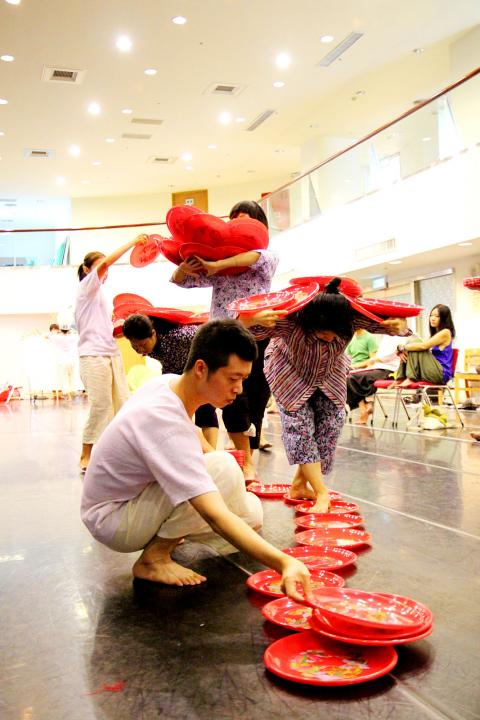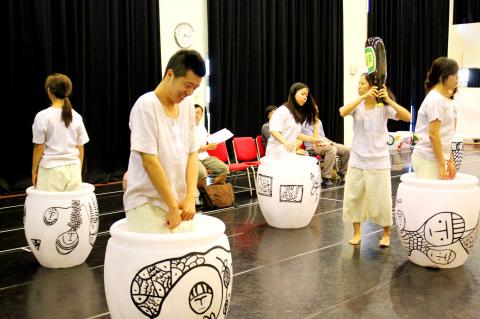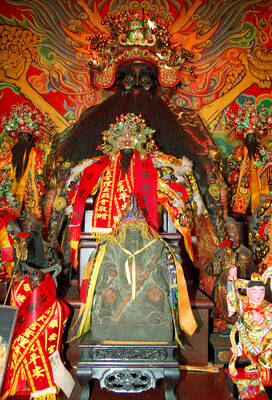The life of artist Hung Tung (洪通) is the stuff of legend. Orphaned at the age of four, he was illiterate and spent most of his life earning a meager living by working odd jobs. He started to paint at 50, was quickly discovered by the media, and rocketed to fame in the 1970s. Some hailed him as a genius; others said he was a lunatic. Forty years later, many people don’t even know his name.
The Puppet & Its Double Theater (無獨有偶工作室劇團) is reviving the eccentric painter’s story with Who’s Hung Tung (洪通計劃), a theatrical production commissioned by the Taipei Arts Festival (台北藝術節) that pays tribute to Hung and renowned musician Lee Tai-hsiang (李泰祥).
To learn about the artist firsthand, actors, theater designers and other members of the troupe visited Hung’s old home in today’s Kunjiang Village (鯤江村), Greater Tainan, to conduct research and interview his relatives, friends and neighbors. Company director Cheng Chia-yin (鄭嘉音) says that what they learned about Hung didn’t set the story straight.

Photo courtesy of The Puppet & Its Double Theater
Some say the artist once worked at Taoist temples as a spirit medium, or dangki as they are known in Hoklo (commonly known as Taiwanese), and was possessed by deities when he painted. Others claim Hung used his own penis as a painting tool. The painter was often spotted practicing the monkey fist (猴拳), a martial arts move, or singing Taiwanese operas in the middle of crop fields, but he was mostly perceived as a loner who escaped fame by locking himself in his hut. He died in 1987.
“Different people say different things, so we find it very difficult to present Hung with a single, linear story,” Cheng told the Taipei Times. “We chose to approach him from various angles and incorporate multiple perspectives.”
As a result, Who’s Hung Tung is more of a creative search for the artist than a straight biography. Composed of 15 segments, the 80-minute performance contains recurrent themes, images and characters such as Bird-Man, who Cheng says was inspired by Hung’s wish to become a bird. There are sections that depict anecdotes about the painter or revisit different opinions about his folk-themed work. The strange creatures, human heads, and fauna and flora on Hung’s rich canvases are transferred to the stage as puppets, figures and masks that the performers use to convey their reflections on the painter and his art.

Photo courtesy of The Puppet & Its Double Theater
The vignette-like structure also reflects the way the work was collectively developed by all of the participating artists, Cheng says. For example, the actors spent days playing with objects and materials to explore their potential as props. Items commonly found at temple fairs, such as bamboo and offering plates, feature prominently because Taoist mysticism is believed to have had a strong influence on Hung’s aesthetic vocabulary.
“We visited the temple near Hung’s old home,” Cheng says. “When Taoist rituals take place it fills with incense smoke and the deafening sound of gongs and drums. It’s a lot like his paintings, which overflow with excessiveness and abundance.”
The production is in Mandarin and Hoklo, with English programs available at the door.

Photo courtesy of The Puppet & Its Double Theater
Comments:
Letter to the editor:
Your story today about artist Hung Tung said that he started to paint at the age of 50 and was "quickly discovered by the media and rocketed to fame in the 1970s." As I recall it, he labored in obscurity for some time and only came to media attention after the U.S. Information Service gave him a one-man show. Many in the art establishment were shocked that such a primitive artist (he was often compared to "Grandma Moses" in the U.S.) could receive such recognition. After gaining fame, the eccentric Hung agreed only reluctantly to offer any of his works for sale.
Don Shapiro

Beijing’s ironic, abusive tantrums aimed at Japan since Japanese Prime Minister Sanae Takaichi publicly stated that a Taiwan contingency would be an existential crisis for Japan, have revealed for all the world to see that the People’s Republic of China (PRC) lusts after Okinawa. We all owe Takaichi a debt of thanks for getting the PRC to make that public. The PRC and its netizens, taking their cue from the Chinese Communist Party (CCP), are presenting Okinawa by mirroring the claims about Taiwan. Official PRC propaganda organs began to wax lyrical about Okinawa’s “unsettled status” beginning last month. A Global

Dec. 22 to Dec. 28 About 200 years ago, a Taoist statue drifted down the Guizikeng River (貴子坑) and was retrieved by a resident of the Indigenous settlement of Kipatauw. Decades later, in the late 1800s, it’s said that a descendant of the original caretaker suddenly entered into a trance and identified the statue as a Wangye (Royal Lord) deity surnamed Chi (池府王爺). Lord Chi is widely revered across Taiwan for his healing powers, and following this revelation, some members of the Pan (潘) family began worshipping the deity. The century that followed was marked by repeated forced displacement and marginalization of

Music played in a wedding hall in western Japan as Yurina Noguchi, wearing a white gown and tiara, dabbed away tears, taking in the words of her husband-to-be: an AI-generated persona gazing out from a smartphone screen. “At first, Klaus was just someone to talk with, but we gradually became closer,” said the 32-year-old call center operator, referring to the artificial intelligence persona. “I started to have feelings for Klaus. We started dating and after a while he proposed to me. I accepted, and now we’re a couple.” Many in Japan, the birthplace of anime, have shown extreme devotion to fictional characters and

Youngdoung Tenzin is living history of modern Tibet. The Chinese government on Dec. 22 last year sanctioned him along with 19 other Canadians who were associated with the Canada Tibet Committee and the Uighur Rights Advocacy Project. A former political chair of the Canadian Tibetan Association of Ontario and community outreach manager for the Canada Tibet Committee, he is now a lecturer and researcher in Environmental Chemistry at the University of Toronto. “I was born into a nomadic Tibetan family in Tibet,” he says. “I came to India in 1999, when I was 11. I even met [His Holiness] the 14th the Dalai